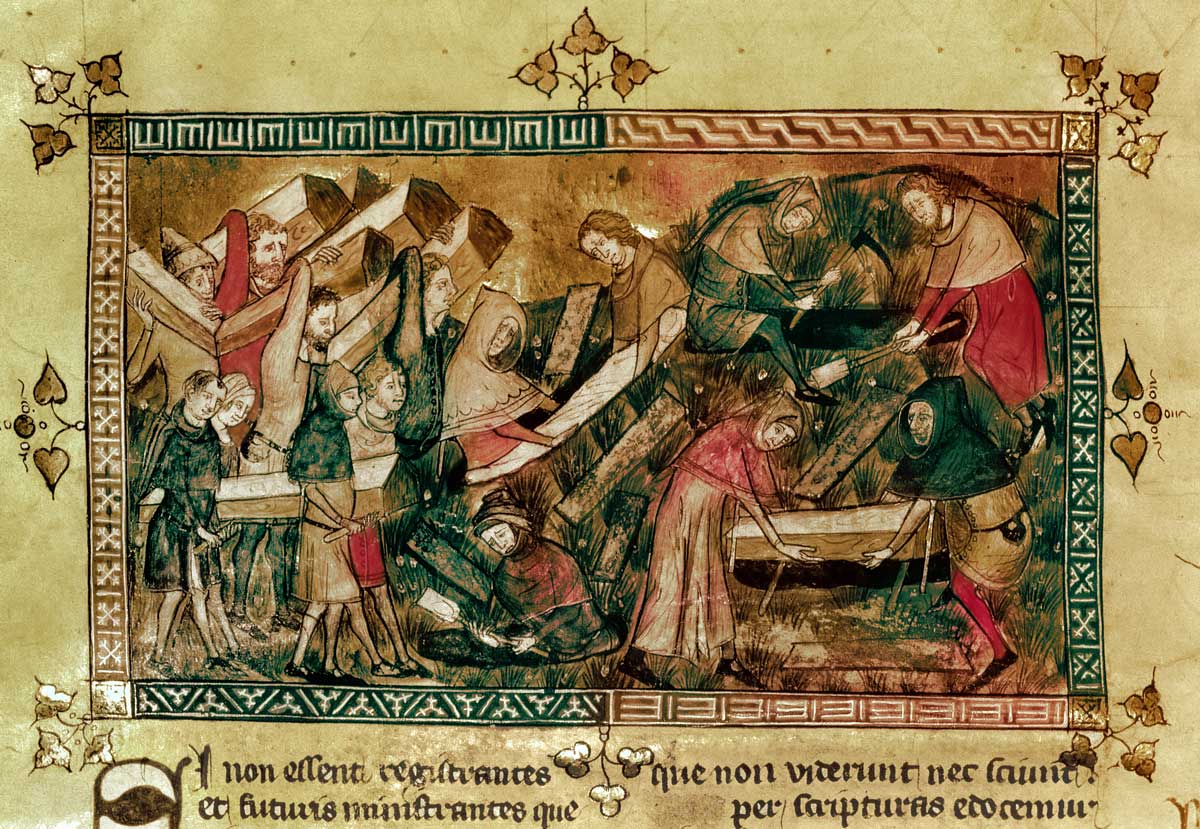The Black Death: A New Culprit? - 10 minutes read
When it comes to the Black Death, rats are usually cast as the villains of the piece – and with good reason. After all, it was most likely thanks to them that the plague (Yersinia pestis) was reintroduced to Europe. Though there has been some debate about how and where the original infection occurred, there is little doubt that Italian traders caught the disease from rat fleas in Black Sea ports before taking it back to Messina aboard Genoese galleys in October 1347. Granted, rats were probably not solely responsible for the speed with which the pestilence spread in the weeks that followed. In 2018, researchers from the universities of Ferrara and Oslo demonstrated that human fleas and lice played at least as important a role in transmission between people. But because rats can tolerate higher concentrations of the bacillus in their blood, and tend to live in close proximity to humans, they greatly amplified its virulence. Exactly how many people died is difficult to establish, but it is estimated that, in the period 1347-53, the plague killed 30-50 per cent of the European population. Understandably, rats have borne most of the blame.
But is this really fair? A recent study suggests marmots might have been just as guilty.
Lost origins
It all boils down to where the plague came from. This is a notoriously tricky issue. Although we know a great deal about the course of Y. pestis after its arrival in Europe, we are much less well informed about the route it followed before reaching the Black Sea. There are no narrative accounts comparable to Giovanni Boccaccio’s Decameron or Ibn Khaldun’s Kitāb al-ʻIbar for regions further east; references to outbreaks of sickness in local sources are often lacking in detail; and Gabriele de’ Mussis’ Istoria de morbo sive mortalitate quae fuit anno domini MCCCXLVIII – which contains perhaps the most vivid description of the plague’s Asian trajectory – appears to have been written without the author ever having left his home in Piacenza.
This has not stopped historians speculating, of course. For many years, it has been assumed that, since the plague was certainly present in the Caucasus in 1347, it most probably began its journey somewhere in Central Asia around 1331-32, before spreading south to China and India and west through Persia. But the exact site of its birth and the reasons for its sudden dispersal have proved elusive. There have been plenty of theories. In the mid-1970s, for example, William McNeill speculated, rather fancifully, that it originated in the Himalayas. By contrast, in the 1990s, Rosemary Horrox placed its beginnings in the eastern steppe and argued that unspecified ‘ecological changes’ drove infected rodents closer to human settlements. But, in the absence of documentary evidence, it has been impossible to say which, if any, of these is right.
The new discipline of palaeogenetics has changed everything, though. In the 1980s, scientists discovered how to recover ancient DNA (aDNA) from archaeological remains – and it was quickly realised that this had the potential to revolutionise the study of the Black Death. The technique was first brought to bear on a piece of housekeeping. Using samples from an unusually well-dated mass grave in London’s Smithfield, it was possible to confirm beyond any doubt that Y. pestis was indeed the causative agent of the 1347-53 epidemic in Europe. But in recent years, it has been used to shed light on the origins and trajectory of the bacillus itself.

The idea behind this is relatively simple. As we all know, DNA is a double helix, consisting of two connected strands, which resemble a twisted ladder. Each ‘rung’ on the ladder consists of a pair of bonded nucleotides. These come in four varieties: cytosine (C), guanine (G), thymine (T) and adenine (A). The combinations in which these occur is distinctive, but over time, the DNA of a micro-organism like Y. pestis will undergo a certain amount of random mutation. An A-T pair in one generation might become a C-T pair in the next. Of course, not all mutations will lead anywhere. Most will simply be outcompeted by the original version and disappear from the gene pool. But, every now and then, a mutation wins out. Either it will give one of the organisms an advantage over the others or – more often – it will be transplanted to another area, where there is less competition and it can establish itself more easily. Once it is dominant, the process can start again.
This means that, for any organism, we should be able to draw a kind of family tree (known as a phylogenetic tree) showing how mutations relate to each other and when a new branch breaks off from the main trunk. The easiest way to do this is by observing the changes as they happen. But it can also be done retrospectively by comparing modern DNA with aDNA. It is not easy, of course. The great difficulty with aDNA is that remains have not always survived for every mutation; and, the further back in time you go, the more gaps there are in the genetic record. But, because mutations occur in sequence, it is possible to identify how many took place between two particular samples – and, by extension, how and when different varieties branched off from one another.
Enter the marmot
This is where marmots come in. As well as rats, Y. pestis is prevalent in a wide range of other rodents, including marmots and some Central Asian species, many of which have been present in the region for millennia. By collecting DNA from plague-infected marmots today and aDNA from human victims in the past, it has been possible to reconstruct the development of Y. pestis from long before the Black Death down to the present day. By correlating this information with the location of the samples, we can even draw a tentative map of its dissemination.
The results are surprising, to say the least. Rather than existing only in a single form, as most had tacitly assumed, it turns out that there are, in fact, four major varieties of the plague in existence today. The first caused the Black Death in Europe; the second split in two, before moving south and east, towards India and the Caspian Sea; while the third and fourth are currently found in Siberia, Mongolia and China. Most importantly, all four appear to have diverged from a common point of origin, at approximately the same time. Though there are obviously limitations to how accurately the date and location can be determined, it has been suggested that this genetic explosion (known, for convenience, as the ‘Big Bang’) most likely took place in the Tian Shan mountains, on the border between Kyrgyzstan and China, at some point in the late 12th or early 13th century – that is, at least a hundred years before the Black Death struck Europe.
Marmots and Mongols
This, however, begs a question. If the ‘Big Bang’ originated in the Tian Shan mountains, how did the new strains of Y. pestis spread so far, so fast?
Clearly, the marmots can’t have done it on their own. Those native to Central Asia are all highly territorial. They tend not to migrate over large distances and generally avoid interbreeding with other species. But, if this is so, what did happen?

An intriguing possibility has been put forward by the historian Monica Green in a recent article in the American Historical Review. Building on a suggestion originally made by Robert Hymes, she has argued that marmots were ‘helped’ by the Mongols. A highly nomadic people, the Mongols had long nurtured a fondness for eating rodents; and, as foreign observers often noted, they were particularly partial to marmots. This was as much a matter of practicality as taste. Found in large numbers throughout the steppe, marmots were a good source not only of meat, but also of hides and fanpi (‘nomad leather’). When the Mongols began their conquests under Chinggis Khan (c.1158-1227), they took their culinary habits with them – with devastating consequences.
The trouble began with the conquest of the Qara Khitai in 1216-18. Also known as the Western Liao dynasty, the Qara Khitai ruled over a large empire, covering much of modern Kyrgyzstan, north-western China, and parts of Kazakhstan – including the Tian Shan mountains. According to Green, it is possible that, by then, the Qara Khitai may already have begun to dislodge Y. pestis from its original heartlands. Either way, it was there that the Mongols first encountered plague-carrying marmots – and, in doing so, greatly accelerated the process. Every time a Mongol killed an infected animal, ate its meat and prepared its hide, they were in danger of catching the same disease. And when the Mongols eventually marched off in search of further conquests, the cured marmot meats and hides they carried in their baggage train transported the plague to new locations, where emerging strains (which might otherwise have been outcompeted) were able to establish themselves with ease.
The ends of the earth
Having thus provided the impetus for the ‘Big Bang’, the marmot-loving Mongols then disseminated the four ‘new’ plagues throughout the Asian continent – and beyond.
By correlating the genetic evidence with known epidemics and accounts of the Mongol conquests, Green has identified the course of each strain of Y. pestis with specific campaigns. The correspondence is striking. In 1253, for example, Chinggis Khan’s grandson, Möngke (1209-59), sent a huge army commanded by his brother, Hulagu (c.1215-65), against the Luri people of modern Iran, the Abbasid Caliphate and the Ayyubid states of the Levant. Sure enough, the second variety of the plague followed close behind. In the wake of major sieges, outbreaks occurred in Girdkuh (1254), Lanbasar (1257), Baghdad (1258) and a number of cities in Syria. So, too, in the 1270s, revolts in Almaliq and Mongolia necessitated the diversion of traditional postal routes and a series of large-scale punitive expeditions. Admittedly, in this case the paucity of records has made it difficult to pinpoint incidents of epidemic disease, but, as Green has pointed out, it is surely no coincidence that it is in precisely this region that the fourth strain of Y. pestis is found today. And, most importantly, campaigns against the Khwarazm Shah (1218-25), Georgia (1220-23) and the Volga Bulgars (1229-32) would have provided the all-important first branch of the plague with a clear route from the Tian Shan mountains to the Black Sea coast.
Needless to say, none of this is immune to criticism. As Green herself has recognised, the connections she has drawn are necessarily speculative. Many will, no doubt, be questioned, or even challenged, in years to come. But in making use of palaeogenetic research, Green has overcome the limitations of the documentary evidence and opened the doors to a remarkable new way of thinking about the origins of the Black Death.
The questions this raises are profound. Now that it is possible to reconstruct ‘hidden’ paths of infection, should we ask if there were outbreaks of plague in other areas of the world, such as sub-Saharan Africa, which left no trace in written record but which nevertheless cut deeply into human experience? If so, how might that change our understanding of wider social and political phenomena?
But Green’s work has also succeeded in shifting a little of the opprobrium from the poor old rat. For, while there is no denying that the Black Death would not have had such devastating effects in Europe without rattus rattus, she has shown that, without the marmot, there would have been no plague – or rather, plagues – at all.
Alexander Lee is a fellow in the Centre for the Study of the Renaissance at the University of Warwick. His latest book is Machiavelli: His Life and Times (Picador, 2020).
Source: History Today Feed